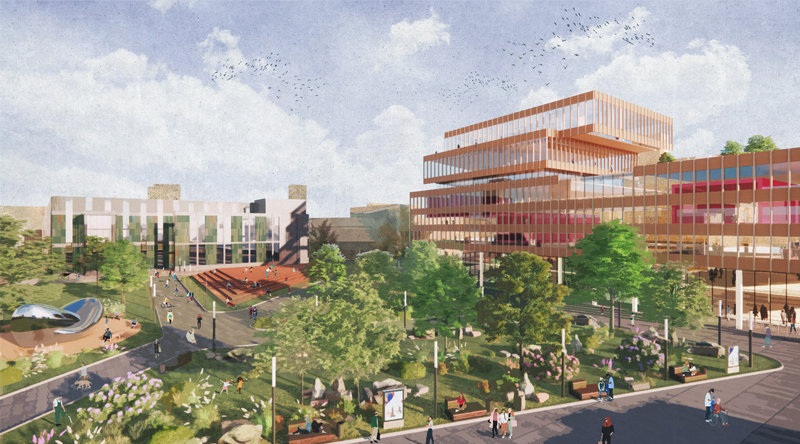By Eric Althoff
HAMILTON, Canada—Design firm BDP has unveiled its master plan for McMaster University. The work at McMaster represents the first North American education project for the international design firm. The master plan is a part of the school’s decade-long plan to bring the school into a new era for the more than 47,000 students, staff and faculty there.
BDP Quadrangle is UK-based BDP’s Toronto-based studio; the design included expertise from the firm’s in-house inclusive design practice known as Human Space. BDP’s vision for McMaster involves creating more green spaces that are simultaneously pedestrian-friendly as well as making the campus more easily accessible to nearby public transit. BDP will be designing several types of housing options, including mixed-use accommodations that combine living and retail environments.
As the campus plan is right now in the development stage, no general contractor has yet been hired.
“Our new campus plan provides a pathway to create a living laboratory for our bold aspirations while keeping sustainability, accessibility, equity and inclusion at the forefront of how we grow,” said David Farrar, president of McMaster University. “This plan imagines places and spaces that can create impact, foster ambition and inspire transformation. We must develop in a way that reflects and supports the quality of the education and research taking place here.”
Sue Emms, principal and head of education at BDP, said that because the educational sector continues to shift, BDP’s design for the new look of McMaster entails fashioning more civic space that is environmentally progressive.
“It is a new civic face for the institution,” Emms said. “We are sure that this campus plan reflects a new, dynamic sector and is a result of extensive consultation with all the people who will use the new campus.
“It is a new vehicle through which McMaster can showcase its global standing in research and teaching, building upon its unique sense of place and developing places that are a reflection of its history, culture and community.”
In addition to fashioning pedestrian-first campus spaces and better connecting McMaster to the public transit sector, BDP’s design also emphasizes the importance of biodiversity. On the western part of the campus, the school will connect more directly to the surrounding natural environments and fashion a “living laboratory” for biological research.
“Our designs will create a revitalized campus that provides a vibrant and welcoming environment for students, faculty, staff and the local community,” said BDP Quadrangle Principal Heather Rolleston. “By prioritizing pedestrian-first spaces and climate-resilient buildings, rewilding parts of campus, and integrating blue-green infrastructure, BDP’s campus design aligns with McMaster’s net-zero carbon roadmap and supports the university’s response to the climate and biodiversity emergency.”


